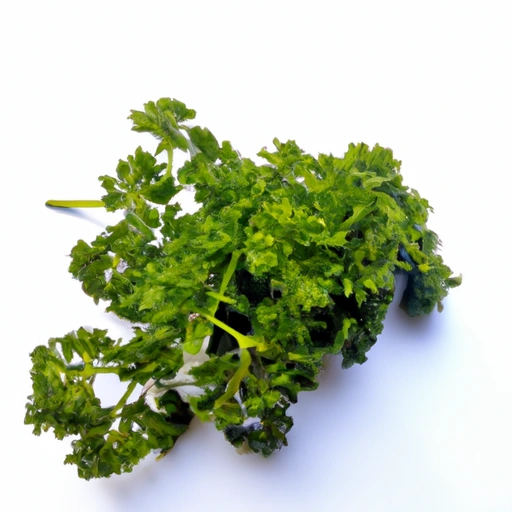Parsley
Description

Parsley is a bright green, leafy herb that is widely used in various cuisines around the globe. It belongs to the family Apiaceae and is native to the central Mediterranean region. Parsley is not only prized for its fresh and slightly peppery flavor but also for its decorative appearance, which makes it an excellent garnish. There are two common types of parsley: curly leaf parsley, which has ruffled leaves, and flat-leaf parsley, also known as Italian parsley, which has smoother, broader leaves.
Common uses
Parsley is commonly used as a garnish, seasoning, and flavor enhancer. Its fresh taste and attractive look make it an ideal finishing touch to a variety of dishes, from soups and salads to meat and fish preparations. It is also a key ingredient in herb mixtures like French fines herbes and Middle Eastern tabbouleh.
Nutritional value
Calories
Parsley is very low in calories, with a 1/4 cup (15g) serving containing approximately 5 calories.
Protein
In a 1/4 cup (15g) serving of parsley, there are roughly 0.5 grams of protein.
Fat
Parsley contains a negligible amount of fat, with less than 0.1 grams per 1/4 cup (15g) serving.
Carbohydrates
A 1/4 cup (15g) serving of parsley has about 1 gram of carbohydrates.
Vitamins
Parsley is an excellent source of Vitamin K, providing over 200% of the daily recommended value in just a 1/4 cup (15g) serving. It is also rich in Vitamin C and Vitamin A.
Minerals
The herb contains minerals like iron, with a 1/4 cup (15g) serving delivering nearly 10% of the daily recommended value, as well as potassium, calcium, and magnesium.
Health benefits
Parsley is known for its antioxidant properties, due to the flavonoids and vitamin C it contains. It also supports bone health because of its high vitamin K content and contributes to heart health by providing folate and potassium. Furthermore, its high chlorophyll content has been linked to natural deodorizing effects.
Potential risks
While parsley is generally safe for consumption, excessive intake can lead to side effects due to its high vitamin K content, which can interfere with blood thinners. It also contains oxalates, which can be problematic for individuals with kidney disorders.
Common recipes
Parsley is used in a variety of recipes such as soups, stews, sauces like chimichurri, salads like parsley salad or tabbouleh, and as a key component in herb mixtures and marinades.
Cooking methods
Parsley can be used fresh or dried and is often added at the end of the cooking process to preserve its flavor and color. It's also used as a key ingredient in pesto and other green sauces.
Pairing with other ingredients
Parsley pairs well with a variety of ingredients, including garlic, lemon, tomatoes, potatoes, fish, poultry, beef, and grains like rice and bulgur wheat.
Summary
Parsley is a versatile and popular herb that enhances the flavor and visual appeal of countless dishes across multiple cuisines. Its health benefits and ease of use make it a favorite among home cooks and professional chefs alike. Whether used as a garnish, seasoning, or key ingredient, parsley is a culinary staple no kitchen should be without.